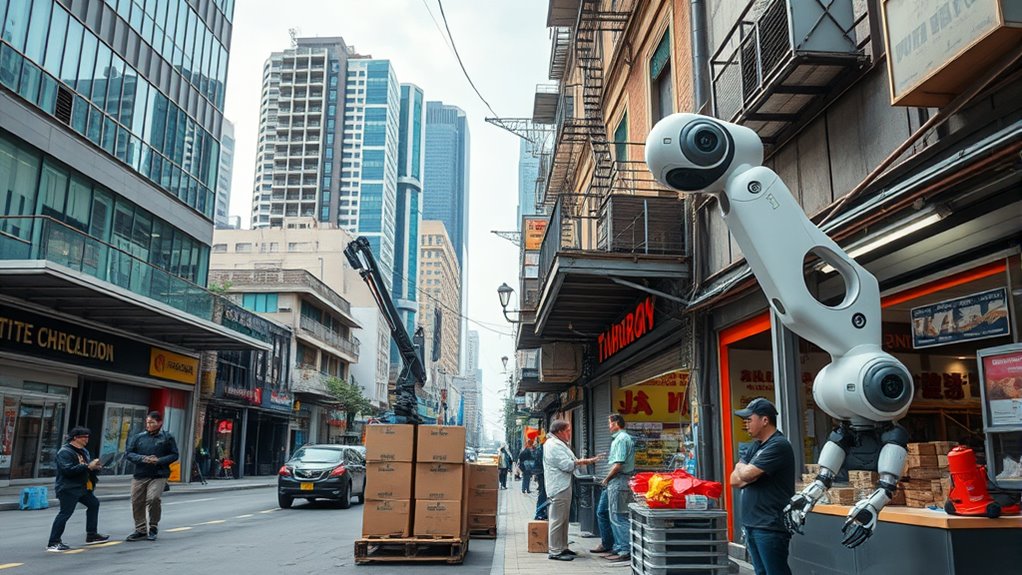Automation now affects jobs across all skill levels, not just low-skilled roles. It transforms many occupations, including medium- and high-skilled jobs in fields like law, finance, and engineering. Tasks once thought uniquely human are increasingly handled by machines, shifting job demands and creating new opportunities. If you want to understand how automation reshapes the workforce at every level, there’s a lot more to explore.
Key Takeaways
- Automation affects jobs across all skill levels, not just low-skilled roles.
- High-skilled professions like law, finance, and engineering are increasingly impacted by AI and automation.
- Routine tasks in medium- and high-skilled jobs are vulnerable, leading to job transformation rather than only displacement.
- Skills such as creativity, emotional intelligence, and complex problem-solving help high-skilled workers remain resilient.
- Continuous learning and adaptation are essential for all workers, regardless of skill level, to stay relevant in an automated economy.
The Broad Scope of Automation’s Impact on Job Types

Automation affects a wide range of jobs across different skill levels, not just low-skilled roles. While routine, repetitive tasks make low-skilled jobs highly vulnerable, automation also impacts medium-skilled roles involving manual and cognitive tasks, like administrative and clerical work. You might find that some of these jobs shift in nature rather than disappear completely, but many face displacement as AI and robots take over routine functions. This broad reach means more than just factory or retail positions are at risk—middle-tier jobs are affected too. As automation spreads across industries and regions, it reshapes the entire labor market. You may notice opportunities shrinking in some sectors while new roles emerge in others, creating a complex landscape for workers at all levels. Current impact shows that automation’s reach extends beyond low-skilled manual labor to include roles requiring moderate skill, affecting a diverse spectrum of the workforce. Additionally, the integration of advanced technology into various sectors accelerates this shift, making it crucial for workers to adapt and acquire new skills to stay relevant. Furthermore, the evolving nature of projected automation trends indicates that continuous learning and skill development will be essential for maintaining employment in the face of technological progress. Recognizing the diversity of job impacts is key to understanding the full scope of automation’s influence on employment patterns. Recognizing these behavioral shifts is essential for developing effective strategies to navigate the changing job landscape, especially as personality traits can influence how individuals adapt to these technological changes.
High-Skilled Roles and the Automation Threat

You might assume high-skilled roles are safe from automation, but technology is increasingly impacting fields like legal, financial, and medical transcription jobs. While AI automates routine tasks, professions requiring advanced cognitive, social, and emotional skills remain more resilient. Still, continuous learning and adaptation are essential to maintain your relevance in these evolving roles. Widespread automation could affect even some high-skilled occupations, highlighting the importance of staying adaptable. As seen in industries such as Hyundai Tuning, performance enhancements are continually evolving to meet new technological standards, suggesting that even niche expertise must adapt to stay competitive. Additionally, developments in AI security underscore the importance of safeguarding sensitive information in automation-driven environments. Recognizing the psychological effects of automation can help professionals better prepare for these shifts and maintain their confidence in evolving workplaces. Staying informed about credit card security and payment processing trends is also vital as digital transactions become more common, helping professionals ensure data protection in increasingly automated systems. Moreover, the increasing integration of cultural narratives in entertainment fields highlights the need for professionals to innovate and adapt creatively as technology advances.
Automation’s Impact on Skilled Work
Although high-skilled jobs have traditionally been seen as resilient to automation, recent trends show that even roles requiring advanced education and expertise are increasingly vulnerable. About 60% of jobs in advanced economies could be impacted by AI, affecting tasks once thought safe. Automation is reshaping job content; high-skilled workers now spend less time on routine data processing and focus more on management, expertise, and communication. Education level doesn’t guarantee immunity—AI can augment or replace parts of these roles, especially in data-driven sectors. While AI can boost productivity, it also shifts skill requirements upward, demanding stronger cognitive, social, and emotional skills. Some high-skilled occupations will grow, but many face displacement, particularly in finance, healthcare, and technology, where routine tasks are most susceptible. Monitoring changes in job roles and responsibilities can help workers adapt to these evolving demands. Recognizing the diversity of tasks within high-skilled roles is crucial for understanding their vulnerability to automation and planning necessary upskilling. Additionally, as AI integration becomes more sophisticated, even complex decision-making processes are beginning to be influenced by automation, further challenging the traditional resilience of high-skilled positions. Furthermore, the integration of automation technologies can alter the traditional job functions, requiring a reevaluation of skill sets and workforce training programs. Incorporating technological adaptability into education and training programs is essential to prepare high-skilled workers for these shifts.
Technology Reshaping Expert Roles
As AI and robotics become more sophisticated, high-skilled roles are no longer immune to automation’s reach. You might think expert roles in fields like law, finance, or engineering are safe, but studies show even these jobs face risks. Automation and AI are performing tasks once thought uniquely human, leading to shifts in job demands. While new roles emerge for highly educated workers, they often require advanced skills and ongoing training. Countries like India see rapid growth in demand for skilled workers, highlighting global shifts. Overall Exposure to AI in the Workforce demonstrates that many white-collar roles, including legal analysts and financial advisors, are increasingly vulnerable to automation, prompting a reevaluation of job security and skill requirements. Additionally, professional expertise is being redefined as automation takes over routine aspects of these professions. Furthermore, the integration of advanced technology in various industries accelerates the displacement of traditional high-skill jobs, emphasizing the importance of adaptability and continuous learning. Recent trends also show that AI-driven tools are transforming workplace dynamics and skill expectations across sectors. Experts suggest that staying ahead requires a commitment to lifelong learning to remain competitive in an evolving job landscape.
High-Skilled Job Resilience
While high-skilled roles have traditionally been viewed as more resistant to automation, recent advancements challenge that assumption. Tasks like data analysis, legal research, and diagnostic imaging are increasingly automated through AI and robotics. Even professions involving complex problem-solving, creativity, and emotional intelligence aren’t immune; automation often leads to transformation rather than elimination. For example, accountants, legal professionals, and engineers face risks of partial task automation rather than total job loss. Data-driven and repetitive cognitive tasks are prime targets, especially as AI models become more capable. However, skills such as adaptability, creativity, and interpersonal intelligence help high-skilled workers stay resilient. Overall, automation tends to shift high-skilled jobs toward higher-level responsibilities, emphasizing augmentation over outright replacement. Automation’s rapid progression means that even traditionally stable high-skilled roles must adapt to remain relevant.
Middle-Income Jobs Facing Automation Challenges

Middle-income jobs are increasingly vulnerable to automation across various industries, with significant portions at risk of being replaced by AI and machines. In sectors like energy, utilities, and mining, nearly half of jobs could be automated by 2030. Manufacturing has already seen 1.7 million jobs lost due to automation, while retail faces the risk of 41 million positions globally by 2040. Administrative and customer service roles, common middle-income jobs, carry risks of 26% and 20%, respectively. Office tasks, legal, education, and production jobs also face automation threats, with exposure estimates ranging from 6% to 26%. This widespread vulnerability means many middle-income workers could see job displacement, wage declines, and ongoing disruption in the coming years.
Skills That Shield Workers From Automation Risks

Certain skills and abilities can help you stay ahead of automation threats. High-level cognitive skills like complex problem-solving, critical thinking, and creativity are hard for machines to replicate. Social and emotional intelligence—empathy, communication, and interpersonal skills—are equally essential, especially in roles requiring human connection. Creative and artistic talents, along with nuanced decision-making based on varied data, also offer protection. Your ability to learn continuously and adapt to new environments is indispensable in staying relevant. Research shows that jobs emphasizing social and emotional skills are less susceptible to automation. Professions such as healthcare, skilled trades, social work, education, and IT rely on these skills, making them less vulnerable to automation. By honing strategic thinking, leadership, communication, and ethical judgment, you can strengthen your resilience against automation risks, ensuring your role remains indispensable.
The Role of Education and Reskilling in Future Employment

Education and reskilling are essential tools for staying relevant in a rapidly evolving job market driven by automation. You need to focus on acquiring digital skills like AI, data analytics, and machine learning, as these are increasingly in demand. Higher education levels correlate with greater exposure to AI, making advanced degrees valuable for maintaining income and job security. Continuous learning helps you adapt to new roles created by automation, especially as jobs shift or evolve. Reskilling programs, often supported by companies and governments, target skills like AI programming and problem-solving. Access to such training varies, but online platforms and micro-credentials are making education more accessible. Staying proactive with lifelong learning guarantees you remain competitive and resilient amid ongoing technological change.
Geographic and Economic Variations in Automation Effects

You should consider how automation impacts different regions unevenly, especially urban high-tech hubs with many office-based jobs. These areas face higher risks of job displacement due to AI, unlike less industrialized cities with fewer cognitive roles. Economic development levels shape how regions experience automation, often amplifying existing disparities.
Regional Impact Differences
Automation’s impact varies considerably across regions due to their unique economic structures and workforce compositions. Rural and nonmetropolitan areas often face higher exposure because many jobs involve routine physical and cognitive tasks, especially in the South and industrial Midwest. Smaller towns with less-educated workforces are particularly vulnerable to automation disruptions. In contrast, urban and suburban metro areas tend to have more employment in sectors like Education and Healthcare, which are less exposed to automation, reducing regional risk. However, metropolitan areas with manufacturing bases, such as Greensboro-High Point and Hickory-Lenoir-Morganton, face higher risks due to industrial job exposure. Additionally, larger urban economies, though proportionally less exposed, could still experience significant impacts due to sectors like retail and food service employing vast workforces.
Economic Development and Automation
Economic development plays a crucial role in shaping how automation impacts different regions and countries. In developed economies, advanced infrastructure and investment capacity lead to higher automation adoption, especially in sectors like IT, finance, and manufacturing. These regions often invest more in automation technologies, boosting productivity and efficiency. Conversely, emerging economies face slower uptake due to costs, limited access to technology, and skilled labor shortages. The digital divide influences digital literacy and readiness for automation shifts. High-GDP countries tend to automate more, particularly in large-scale farms, healthcare, and logistics. This variation means automation’s effects differ markedly across regions, with developed nations experiencing faster productivity gains. Understanding these geographic and economic differences helps you grasp the uneven landscape of automation’s impact worldwide.
Frequently Asked Questions
How Does Automation Influence Job Satisfaction and Workplace Culture?
Automation influences your job satisfaction and workplace culture by streamlining tasks and reducing monotony, allowing you to focus on more meaningful, creative work. When properly implemented, it fosters a culture of innovation and continuous learning. However, if your skills don’t match automation demands, it can cause fear and dissatisfaction. Supporting training and aligning automation with your values helps improve morale, making the workplace more adaptable and positive.
What Industries Are Most Resistant to Automation Disruptions?
You’ll find that industries like healthcare, personal care, education, and creative services are most resistant to automation disruptions. These fields require adaptability, emotional intelligence, and complex decision-making that tech can’t replicate easily. Skilled professionals in unpredictable environments, such as caregivers or teachers, rely on nuanced human interactions. Automation struggles with the variability and social complexity involved, making these industries more resilient and emphasizing the importance of human skills.
How Do Automation Trends Affect Global Income Inequality?
You might find it surprising that automation could widen global income inequality, with over half of income gaps attributed to technological changes since 1980. As AI boosts productivity mainly in wealthy countries, it leaves poorer nations behind, deepening economic divides. High-income nations and their tech owners benefit most, while low-income countries struggle with limited access. Without intervention, automation risks further entrenching global disparities, making inclusive policies more essential than ever.
Are There Specific Tools or Technologies That Help Workers Adapt Faster?
You want to know which tools help workers adapt faster, right? AI-powered learning platforms personalize training, offering real-time feedback that speeds up skill development. Immersive tech like VR and AR simulate real-world scenarios for hands-on practice. Decision support tools assist with complex tasks, reducing cognitive load, while self-service digital resources give instant access to training and analytics. These technologies combined make adaptation quicker and more efficient for you.
What Role Do Government Policies Play in Managing Automation’s Workforce Impact?
Government policies are like the superheroes fighting to save your job from automation’s relentless advance. They streamline workforce programs, promote tailored training, and fund large-scale reskilling efforts that prepare you for the future. By fostering collaboration between industries, unions, and educators, these policies guarantee automation becomes your ally, not your enemy. They’re your shield against displacement, transforming technological change into new opportunities for growth and job security.
Conclusion
You need to stay informed, adapt your skills, and embrace lifelong learning. You must recognize that automation affects all job levels, demanding continuous upskilling and flexibility. You should focus on developing skills that computers can’t replicate, like creativity, problem-solving, and emotional intelligence. By doing so, you’ll protect your career, seize new opportunities, and thrive in an evolving job landscape. Stay proactive, stay resilient, and stay ahead of the automation wave.









